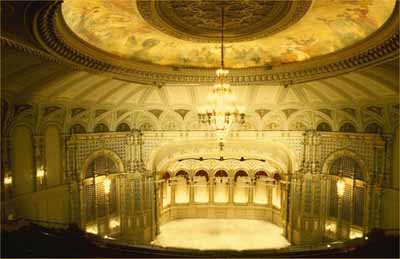Orpheum Theatre National Historic Site of Canada
Vancouver, British Columbia

Interior view
(© Parks Canada Agency / Agence Parcs Canada)
Address :
884 Granville Street, Vancouver, British Columbia
Recognition Statute:
Historic Sites and Monuments Act (R.S.C., 1985, c. H-4)
Designation Date:
1979-11-15
Dates:
-
1926 to 1927
(Construction)
-
1974 to 1977
(Alteration)
Event, Person, Organization:
-
Ivan Ackery
(Person)
-
B. Marcus Priteca
(Architect)
-
Frederick J. Peters
(Architect)
-
Thompson, Berwick and Pratt
(Architect)
Other Name(s):
-
Orpheum Theatre
(Designation Name)
Research Report Number:
1979-53
Plaque(s)
Existing plaque: 884 Granville Street, Vancouver, British Columbia
The Orpheum theatre, designed by B. Marcus Priteca and opened in 1927, is a good example of a Canadian movie palace, and one of the few to survive in relatively unchanged condition. Movie palaces, once found in most large Canadian cities, were a distinct form of theatrical architecture which flourished in North America between 1914 and 1932. They were erected by continental circuits (in this case the Orpheum Circuit) and offered films and stage shows, with theatre organ and orchestral accompaniment, in massive, lavishly decorated buildings. In 1973 Vancouver acquired and renovated the Orpheum as a municipal theatre.
Description of Historic Place
The three-storey Orpheum Theatre is located in the busy entertainment district of Vancouver, adjacent to other historic Edwardian commercial buildings on Granville Street. Expanded in the 1980s, a new entrance to the theatre was created on one side of the building, with the Granville Street elevation retaining its original symmetrical brick and terra cotta façade with a large canopy and vertical neon sign. The official recognition refers to the interior and exterior of the building on its legal lot.
Heritage Value
Orpheum Theatre was designated a national historic site of Canada in 1979, because it is a good example of a Canadian movie palace, and one of the few to survive in relatively unchanged condition.
Considered the ‘Grand Old Lady of Granville’, Vancouver’s fourth Orpheum Theatre was one of seventeen grand movie places in Canada built by the Chicago-based Orpheum Circuit and the largest and most extravagant theatre on the Pacific Coast. It exemplified the faith of the company in the metropolitan growth of Vancouver and it became a symbol of Vancouver’s progress.
The Orpheum Theatre was designed by B. Marcus Priteca, a Seattle-based architect who designed nearly two hundred theatres from San Diego to Alaska. Priteca introduced many innovations to theatre design including the triple-domed ceiling, a deep, cantilevered balcony with carefully angled seating for improved sight lines, an orchestra pit, and a mezzanine. Priteca was also a master at economically creating the illusion of opulence with plasterwork on reinforced concrete. Frederick J. Peters was the associated architect on the project.
The Orpheum is an excellent example of theatre design of the 1920s. Centrally located in an urban area, it offered a large seating capacity, spacious foyer and lobby areas, and a lavish interior décor that created an atmosphere of exotic luxury. Throughout the richly decorated common areas of the theatre are a series of repeating motifs such as colonnades that provide constant visual stimulation and multiple, controlled perspectives. The design is a mélange of architectural influences - the vaulted ceilings of the main concourse and foyer and the terra cotta undersides of the marquees and the travertine walls and pillars are Italian influenced, there are exotic ceiling motifs, crests of British heraldry, chandeliers of Czechoslovakian crystal, Moorish-inspired organ screens, and Baroque ceiling and dome covers.
The Orpheum Theatre was an important landmark in the development of Granville Street as entertainment area from the 1920s to the 1940s. Long under the management of master showman Ivan Ackery, a number of prestigious acts have graced its stage, many related to Orpheum Circuit productions. Audiences have been entertained by symphonies, vaudeville acts and movies by some of the world’s most famous performers. The Orpheum hosted Vancouver’s first radio theatre and it is home to B.C.’s ‘Starwall Gallery’ inside the theatre and ‘Starwalk’ along theatre row to honour British Columbians who have excelled in all disciplines of the entertainment arts.
The theatre was one of the first large-scale heritage conservation projects undertaken in Vancouver. Between 1974 and 1977, renovations were carried out by the firm Thompson, Berwick, Pratt and Partners of Vancouver. Today the theatre thrives as the city’s premier concert hall and as home to the Vancouver Symphony Orchestra.
Sources: Historic Sites and Monuments Board of Canada, Minutes, November 1979; Screening paper, 1979.
Character-Defining Elements
Key elements that contribute to the heritage character of the Orpheum Theatre include its:
exterior design with classicized symmetrical façade, brick and terra cotta facing with decorative pilasters, large round-headed window, and balustrade along the roofline, entrance canopy, vertical neon sign on the Granville Street façade; reinforced concrete construction with steel girders; its interior layout with triple-height foyer decorated with cast stone colonnades and elegant coffered ceiling, and the grand unified interior space of the auditorium defined by the richly plastered vault and dome built upon a metal frame and suspended from steel girders and massive trusses crossing an unbroken span of 36.5 metres, its cantilevered balcony created by a network of counterbalanced steel trusses, and the grand staircase ascending through several landings to the main level of the auditorium; decorative finishes including European-inspired plasterwork, terrazzo floors, travertine walls, marble bases, highly ornate ceilings, elaborate grand staircase balusters, plaster decorative trim and moldings, Czechoslovakian chandeliers, and two silk and hand embroidered Chinese tapestries ‘Long Life’ and ‘Happiness’ presented to the theatre by the Chinese Community in 1927; repeated series of arches that create a sense of unity and progression to the stage in addition to punctuating space and creating a series of ‘stages’ in the lobby; hardwood (maple) stage; built-in (former) projection booth constructed of reinforced concrete; the rare Wurlitzer Theatre Pipe Organ.